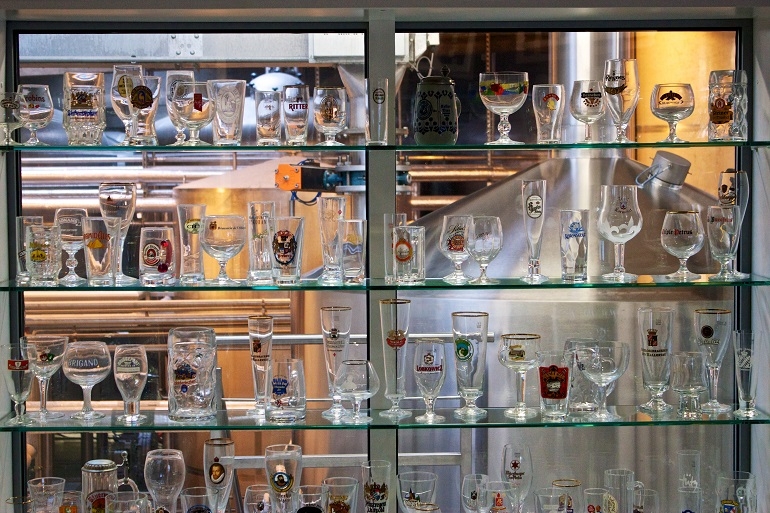Start 14-Day Trial Subscription
*No credit card required

Beer 101: Temperature, Pour, and Glassware
When it comes to beer’s temperature, the common belief is “the colder the better.” This is not always sound advice. Beers served too cold can numb the tongue and deaden the taste buds to the delightful flavors within. Letting a beer warm up just a bit can unlock the flavors and enliven the character of a well-crafted beer. The temperature at which you serve different beers is often a matter of personal taste, but if you are seeking guidance, here are some serving suggestions that may bring out the individuality of certain types of beer.
Very Cold: (35-40° F) American Premium Lagers, Low-alcohol beers and Cream Ale.
Cold: (40-45° F) Hefeweizen, Pilsner, Kolsch and Wheat Beer.
Cool: (45-50° F) Stout, Porter, Amber Lager, Pale Ale and IPA.
Cellar: (50-55° F) Bock, Belgian and Trappist Ale, Lambic/Gueuze, Sour Ale and Strong Ale.
Warm: (55-60° F) Double IPA, Doppelbock, Barleywine, Quadrupel and Imperial Stout.

Photo Credit: Fabio Petroni (from The Beer Sommelier / White Star publishers)
BEER POURING
There are times when saving time and drinking a beer straight out of the bottle just feels right. Some breweries even recommend drinking directly out of the bottle or can (The Alchemist’s illustrious Heady Topper springs to mind). But if you really want to bring out the best in a beer, a good pour is crucial.
Glassware Preparation
Simply put, a beer-ready glass is a clean, sanitized glass. A dirty glass can create a flat beer or a false head that dissipates quickly. It can also make the beer taste “off” and cause bubbles to stick to the side of the glass.
1. Wash the glass in warm, sudsy water.
2. Rinse it in clean water.
3. Let the glass air-dry upside down on a rack.
The Perfect Pour
Contrary to popular belief, beer should not be poured down the side of the glass. To allow the carbonation trapped after fermentation to escape and to create a proper head of foam, follow these instructions:
1. Start with a clean, beer-ready glass. Note: Avoid serving beer in a frozen glass as it dulls flavor and aroma.
2. Remove the bottle cap or can top. Use a good opener so you don’t damage the lip of bottle. Hold the bottle at the top and not the bottom; rough handling can cause the beer to foam or gush.
3. Put your glass on a flat surface. Place the neck of the beer bottle over the glass without it touching.
4. Quickly raise the bottom of the bottle and pour straight down the middle of the glass, releasing the natural carbonation.
5. Once you have a tight collar of foam, lower the angle of the bottle, pour gently and as the foam rises to the top.
6. Enjoy!
GLASSWARE
Pint Glass:
The American pint glass, or Shaker glass is the most common. English pint glasses are called Imperial or Nonic glasses, and have an extra bulge near the top which allows for easier stacking (hence, no nicks in the rim), and usually holds 20 ounces to the American’s 16.
These types of glasses are perennial pub favorites because they’re cheap, easy to clean, and of course, stackable.
Beer Mug:
Great for gripping and sipping, the beer mug is a common way to drink ales and lagers, usually in larger quantity. The glass is thick, and can withstand the most forceful post-toast clinking, and the subsequent slamming on the counter to signify that you are ready for another.
The thickness also keeps the beer colder, and the handle keeps your hands from transferring heat to the glass. Volume can vary from 12 ounces to a small lake’s worth.
Snifters, Goblets, and Chalices:
Beers with strong malt or hop profiles are great for this type of glassware. The bowl shape of the glass allows for the concentration of aroma, and can enhance flavor.
Variations on a theme, snifters generally have a wider bowl and mouth than goblets and chalices, but a shorter stem. A chalice is generally the same as a goblet, but made with thicker glass.
Don’t be ashamed to give the glass a swirl to help release the aromas.
Weizen Glass:
Made for wheat beer, with a narrow base and wider top, which is focused on preserving the thick head. The length of the glass makes it easier to see the color, clarity, and carbonation of the beer.
Pilsner Glasses:
Similar to weizen glasses, but with less curvature, pilsner glasses are designed to retain the head of your beer, and allow for visibility. As the name implies they are made with pilsners in mind, but work well with other lighter styles.
Tulip Glass:
The tulip glass has a rounded bowl shape, but narrows at the top, concentrating aroma and allowing for easy swirling. This style works well with dark and powerful beers.
Flute Glass:
The long, narrow shape of the flute glass enhances carbonation and helps release aromatic volatiles, which works well with effervescent lambics and crisp fruit beers.
Stange Glass:
Initially made exclusively for drinking Kölsch, the straightforward stange glass helps amplify subtle malt and hop nuances of this delicate German style, and works well with similarly balanced and nuanced styles, like lighter bocks, altbier, and gose.
A note on anodizing: Glasses are often anodized, or laser etched in a variety of shapes. These markings serve as a nucleation point for carbonation, ensuring a consistently frothy head.



